Calculator Types Calculator blog
Calculator blog
Musings and comments about our common interest
Just received my first 30b - first impressions
Today I opened the box of the 30b and had my first stint with it. I will do a formal review in some time from now, but cannot avoid making some comments on the fly.
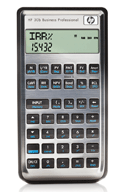
To give a reference, I think that the best financial calculator is the HP17bII - from the viewpoint of having all of them. I think also that the latest HP17bII+ is the best of all, followed by the first HP 17bII.
I have been surprised by the 30b. It has an amazing number of functions, including hyperbolics and inverse trigonometrics. SIN, COS and TAN are not even hidden in menus. It has menus for a number of items that we had to program in the past. The menus, although not as efficient as the screen keys of the HP17bII, are surprisingly logic. It took me all of 2 minutes -without looking at the manuals- to figure out how they work. (I have the break even formula programmed in a way or another in all of the calcs I have - now I have a specific menu for it). Date menus are very intuitive and contain DATE+ and DDAYS within the same menu (just like the calendar functions of the 17bII) Overflow is at E499, instead of E99. Factorial is applicable to real numbers (really a gamma function then). I see 12 significant digits. A curious feature is that you can edit the number in the screen anytime - even when it is a result!
I see it as a very all-weather, all-terrain calculator: so far I have not seen anythin I do on a daily basis that I cannot with the HP 30b.
Keys are clearly better than the competition, but still not at the same level of 12c or 17bII. Still, a very clear feedback and had no missed or duplicated keystrokes. Screen is well protected by the bevel at the border, and it has a good contrast. A small criticism: the black shiny back keeps all the fingerprints until cleaned. It is a very light machine as well, not as classy as the 12c or the 17bII but much better than the 20b.
There are many areas that I have not explored yet - like programming, decimal logs, Black and Scholes, etc.
Stay tuned for the full review!
The HP85 and my 7 year old
This last Saturday my 7 year old asked me about the green suitcase in the mountains cabin. "What's this, Dad?
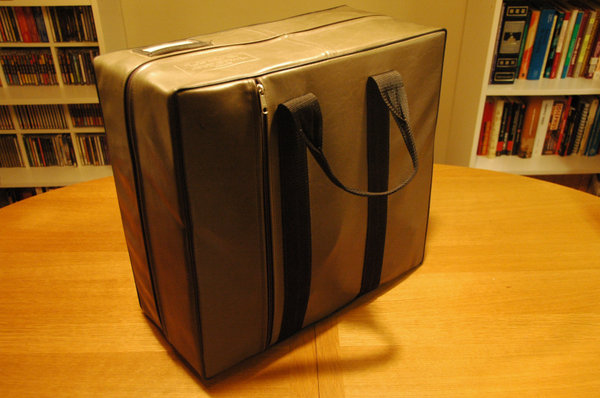
"A portable computer, Guillermo"
"That big? Can I see it?"
"Yes you can"
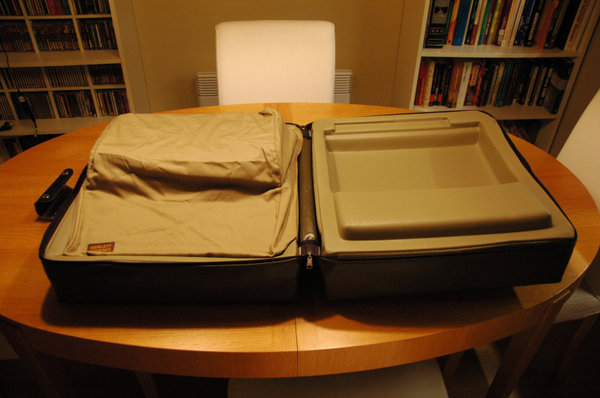
"What can you do with it? Can we see YouTube with it?" (sometime ago he asked me "when you were a child, did you like to use Google?" How to explain that there was no Youtube, no Google, no www, and in my case, no network even around 1981 )
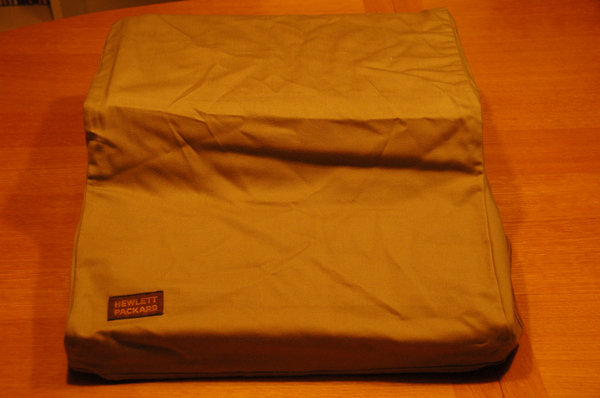
"No, you can't"
"what can you do with it, then?"
"You can make programs. You instruct the computer to do what you want"
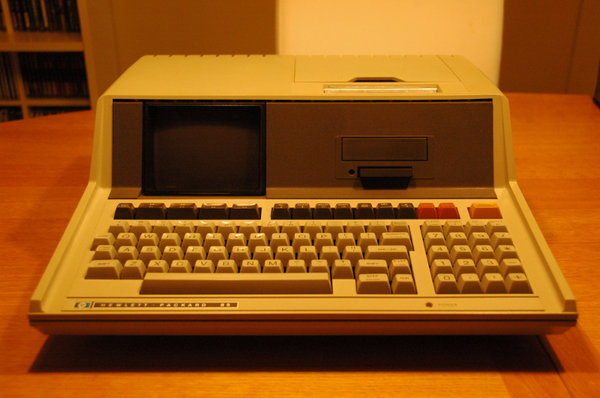
"you are joking, aren't you? Does it work?"
"Yes it does. See?"
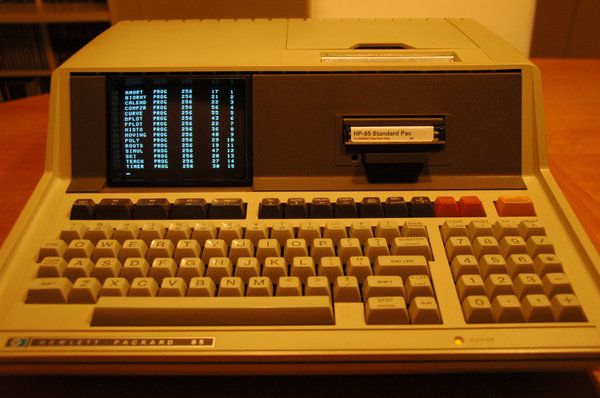
"What's that thing on the right?"
"A tape drive. It is like a USB memory - just slower and with less memory. You can write your programs in it, and you can retrieve other programs other people have written. Do you want to tell something to do to the computer? Let me help you."
"OK. Let's have it print 'IRONMAN' on the printer.
10 PRINT "IRONMAN"
20 END
"OK. How can it print it many, many times?"
"Let's try"
10 PRINT "IRONMAN";
20 GOTO 10
"Isn't GOTO misspelled?"
"No. It is a program keyword. It is not English. It is a computer language, similar to English. It is used to give instructions to the computer. Let's try something else. Now you are learning how to multiply. Let's have the computer print the multiplication tables, OK?"
"OK"
10 REM GUILLERMO'S MULTIPLICATION TABLES (some explanations on what is a comment)
20 DISP "WHAT MULTIPLICATION TABLE TO DISPLAY";
30 INPUT T ("T is the name of a box where we put the number we want to print the table for. It is called "a variable"")
40 FOR I=1 TO
50 PRINT I;" X ";T;" = ";I*T
50 NEXT I
60 END
"Dad, can we tell the computer to play a game?"
"Yes, we can, but that'll take longer. Besides, you need now to do your homework. Next week end, OK?"
"OK"
It had been a wonderful afternoon. He was hooked. Next week we will try to do some drawings.
Convert HP15c in a financial calculator - in addition to be one of the best scientific there were!
Let's start a short project.
As engineer, I tend naturally to scientific calculators, but in the daily life we need to get into business more often than not.
You need to discuss the profitability of investments, their net present value, and several value of time issues. That is, IRR, NPV, TVM. While it would be good to have flows as long as you need, in my company all projects are calculated over 10 years - except acquisitions, and these are not discussed over a calculator.
You need to plan projects, and need to calculate how many days are left from now to then - that is, DATE+ and DDATE calculations.
Regarding %'s, the HP15c comes with % and increment%, but it misses the %T. It will be good to have a weighted average as well.
Depreciation is always linear - I do not need to make a program to calculate that. Bonds I will not use.
Black and Scholes would be nice to have - to show off. We do not use it in our industry. Instead it would be good to have optimal stock ordering.
I have not used it yet, but I see some linear programming coming - so I would rather keep at least room to solve a 3 equation linear system: 9 + 3 = 12 registers free for matrixes. As I said, let's use 1 register for initial investment, 10 registers for flows and 1 more for management (in addition of I as counter). This adds up to 24 registers, leaving 65-24 = 41 registers for programming. This equals to 287 steps. Let's see what we can do.
This is a project that will take some spare time. It is far from the complexity of the HP30b or HP12c+ repurposing projects being carried by some people. Nevertheless, it will be important if (when?) an HP15c+ hits the market.
New products coming
Our contacts in HP have informed us about several new products in the pipeline. There are ultra-new things and some less new (to say the least) in the works. Estimated time of arrival on European shelves is July - maybe announcement will come sooner.
One of the calculator projects will likely sell in the millions (not hundreds of thousands - millions!) but the other will be a limited run of 10000 units - and that's all.
HP revamped their calculator strategy several years ago and allocated resources and clever thinking (not that there wasn't before, but there were fewer persons on it). After a number of years wandering around the world (even ACO: Australian Calculator Operation, of all places), there was a move back to the US, first to San Diego and now to Fort Collins. After several years fearing HP would leave the calculator business completely, I now look forward to a list of new products and exciting projects.
It has been easy to critizice HP for failing to live up to its heritage, but no more. Just wait some months and you'll see.
UPDATE: just look at this:http://www.techpoweredmath.com/hp-12c-special-edition-hp-15c-re-release/
New HP50g vs Classic 15c
I see the old HP15c derided by current users by comparing it with HP 50g. They laugh at the specs, the screen size, the programming model, etc. They wonder how mint units can get over 300 € on ebay and other sites.
I have both. In my common work, I use the HP 50g. I can see everything that I have done - sometimes I need to clear to unclutter the stack. However, it is clear to me that it is not a calculator for all purposes: I cannot take it to meetings, or when discussing with a colleague some alternatives, etc. For that, I have in my jacket the HP15c. (For that matter, I could use the HP42s instead - however, it takes longer to navigate the menus and do what you want than on the 15c)
The HP 15c is the unit I take with me in airplane flights, to discussions, when going out shopping, etc. (whenever any of you would make a calculation in your iphones, I'm done long before with the 15c - with the advantage that I can tall the result to the person on the other side of the phone!)
In the past, when there were comparisons with the hp 41c, I/O was a factor - no more (infrared is not often used, since sales of infrared printers are so low, and there are no instruments that can interface with the HP50g, save for the streamsmart model, which is a high school application with no professional instruments to attach.
The programming capabilities of the 15c are more than enough for most business or engineering problems, due to its extense function catalog. There is as well the fact that it will last forever with a set of batteries, while you need to change the 50g batteries every two months id you use it frequently.
If I have both at hand, it's the 50g that I take. If I have a program to do, or solve an equation, it's the 50g I turn to.
I do not want to choose - I want both.
I heard rumours that you will not have to choose, too.
My HP calculator history (I)
At the same time, I had access to a HP85 computer. Now I see it called a "calculator", but at that time it was considered the very top of professional computing. Apple ][ were considered toys compared with it. It had a decent BASIC language, provision for extended number precision (exponents up to +-499), could run from its ROM without the need of loading an operating system, and it had an integrated mass storage system (256 kbytes magnetic tape) and thermal printer for output. Best of all, it had HP-IB and with it a world of interfacing. In the application we were using it, we were printing invoices with a dot-matrix printer, drawing with an hp 7225A plotter and storing data on floppy discs. Later it came a 5 Mbyte winchester disk ("how on earth are we going to fill it up!"). To add the cream on top, its capacities could be expanded with additional ROMs (up to 6) that could be plugged on a card on the back of the computer.
The manual is absolutely the best computer or calculator manual I have ever seen. Never, ever, HP has approached that level of perfection. It went through all concepts and programming techiques with full details and lots of relevant examples. You can see examples of that manual at www.series80.org. It would be an excellent primer for programming for your children.
The keyboard feels a little primitive compared with today's examples, and the machine is clocked at around 650 kHz (meaning kHz, NOT MHz or GHz !!). The basic is interpreted and quite slow. Please remember that this machine is a couple of years older than the first IBM PC. But it was an excellent general purpose machine, best suited to engineering and industry. I have a warm spot in my heart for it since I made my first money writing programs for it.
Nowadays I have an HP85 sample that works flawlessly -except for a clear area in the printhead. The tape machine has been exchanged for a QIC one, with newe tapes, and all the ribbons of the printer have as well been exchanged. The fact that it continues to run after 30 years attests to the quality of HP of yore.
Coming back to calculators...
The HP33c calculator accompanied me up to 3rd term in Engineering - that is, 20-21 years old. Then I moved to a BASIC Casio for the rest of University. This allowed me to do some complex mathematical programming. The BASIC alternative would have been the 71b -but at several times the price of the Casio - but I always was longing for a HP 41c
3 years after I joined an MBA program in Barcelona, and bought an HP19bII. I felt I was betraying the engineering profession by buying a non-programmable, non scientific calculator. I should not have felt that way: it is a fantastic calculator and the solver allows for quite interesting programming. At the time, the alarms and time functions made it quite similar to a personal organizer. The main problem with it was the "real estate" it used on your working table. It was stolen from me, and then I replaced it with an HP 17bII - the original model. I missed the 3 lines display - but it was good enough. I still have that calculator. We were in 1994.
Fast forward to 2006 - after a number of years in finance positions, I enter a general management position, where sin and cos and logs are used, and I am no more money-starved. Then I decided to buy the best there is...the HP 41c - or so I thought...
I bought an HP 41cx, but it appeared that I had passed by a number of exciting calculators for over 15 years: the hp 42s (a 41c+ with an even better form factor) and the hp48 world...I just had to explore it. In a couple of years, I built the collection I now have.
My current preferred calculators are the hp15c and the hp 50g
I use the 50g in my daily work. I can write programs in RPNish RPL (RPL using only the RPN techniques) and the solvers. I use as well the matrix capabilities to manage budgets and company forecasts. I am in business long before my companions have entered the passwords in their Wintel laptops.
I "wear" the 15c in my jacket. It has the right size and format to help me working in the airplane or the high speed train. I have programmed it to add it most of the features of the 12c: date calculations, IRR, NPV, weighted averages, time value of money, etc. It actually is faster to use in most simple applications than the 50g - except when the solver is required. However, programs are extremely slow - when I calculate an IRR, 2 minutes are typical for a 10-year calculation. I guess that I'll have to wait for the hp15c+ (hp15c firmware in a new hp12c hardware)
I could wear the 42s - that I also have. I have developed as well the financial programs that make it similar to the HP17bII - but the solver is not the same as the latter, or the hp 50g for that matter. I prefer the 15c or the 50g - depending on the application.
In a later post, I will discuss in depth these three calculators.
Start up a new blog
Well, this is the first entry in the blog. I will try to give you as much information as I receive from (or I am allowed by) Hewlett Packard. I know for a fact that some interesting projects will appear in the months to come - including a reissue of a famous calculator. Guess which one? hint: is one of the two most preferred by HP calc lovers. It will be an "anniversary-type" product, limited to 10.000 units, so you'd better grab it as soon as you see it. First production samples are scheduled on May, and you will see it first here... The second project will be something much bigger. It will not only be "from" China, but "for" China. I will keep you posted as well as soon as I know it.



